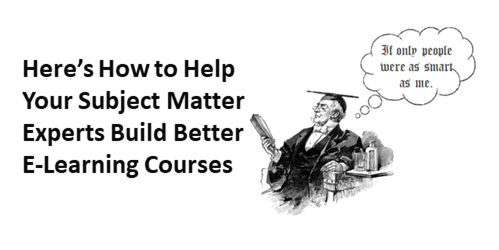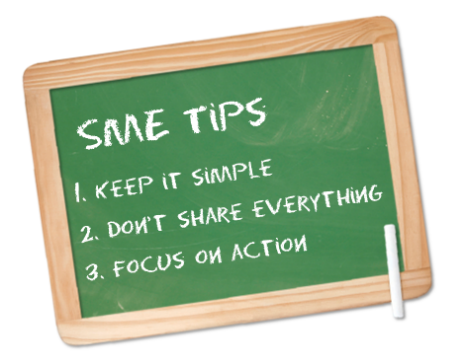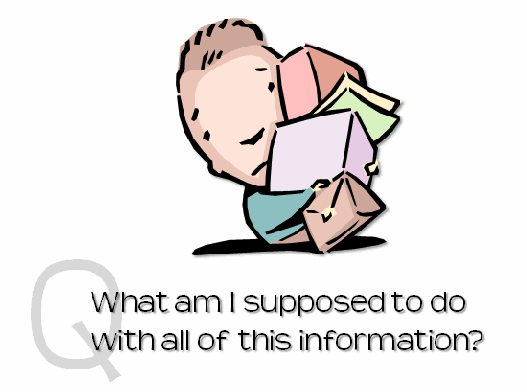Help Your Client See E-Learning from a Different Perspective
January 25th, 2011
Most people only see linear, click-and-read elearning courses. So when it comes time to build their own courses, they tend to build what they’ve seen before. The same goes for your clients or subject matter experts. They tend to expect something similar to what they’re used to seeing.
There are many times when a linear, click-and-read course is appropriate. So this isn’t a rant against click-and-read courses. However, there are also plenty of times, where a click-and-read course isn’t the best solution. In those cases, it can be a challenge getting your client to see past what he’s used to and considering a different approach.
Today, I’d like to offer a few ideas to help your client and subject matter experts understand what type of course they need to build.
Clarify the Course Objectives
What does the client expect as an outcome? I’ve worked on plenty of projects where the outcome was only to have the course tracked at the end of the year. And I’ve also worked on courses where the client expected real changes in performance.
In clarifying the objectives, steer the client away from courses that don’t offer any tangible value. If the course isn’t aligned to tangible goals, then most likely it’s a waste of time. But the reality is that sometimes you still have to build courses where the only real objective is that at the end of the year some group can say X people went through each course and got a 100% on the quiz.
In those cases, try to commit the least amount of resources possible. You can build simple courses that look good and meet your client’s goal without spending a lot of time and money. Your client will be happy and you free up your time and money for the more meaningful courses.

If you’re new to this, I recommend the Performance Consulting (2008) book. It does a great job walking through the process of helping your clients understand their performance goals and objectives. Knowing this will help them build impactful courses. I’ve also heard good things about The Performance Consultant’s Fieldbook.
Key points:
- Determine objectives
- Align objectives to performance goals
- Allocate resources appropriate to the objectives
Determine Which Type of Course is Best
If you listen to some in our industry, you’d think that any elearning course that isn’t performance-based is wrong. I don’t take that view. Instead, I see an elearning course just like any other medium used to support the learning process. It’s a tool to facilitate learning. Sometimes it’s the only tool, and sometimes it’s just one of many.
When it’s the only tool, then it makes sense to be as complete as possible. In those cases, the course probably needs more performance-based interactivity. However, if it’s augmented by other tools and activities, then perhaps an information-only focus is fine. And because, it’s information-only doesn’t mean it has to be linear.

Look at the way the news industry creates infographics. They’re not that much different than many elearning courses. Information-only doesn’t mean it has to be linear; or that all of the information needs to be buried in job aids or PDFs.
The question ultimately lies in the doing. What is the learner supposed to do with the course information and WHERE is it done? I can build a performance-based course where the doing is built into the elearning course with various interactive elements like branched scenarios and case studies. Or I can build an information-based course where the doing is outside the course in the real world. For example, I compress the delivery of information into simple elearning modules and combine them with some facilitated sessions in the real world.
Key points:
- What is the learner to do with the course content?
- Information-only can stand alone or be augmented with activities outside of the course.
- Performance-based expectations require appropriate interactivity inside the course.
Present Alternative Types of E-Learning
Going back to the opening paragraph, we tend to expect those things with which we’re familiar. Odds are that your client doesn’t have a lot of exposure to different types of elearning.
It’s your job to help them see the light. Expose them to different ideas and you’ll probably build better elearning. An easy way to do so is to offer a few treatments. Take some generic content and then build out a few versions of how it could be treated as an elearning course.

If they want an information-only course, show them some examples and how that type of course would support their learning goals. This is also a good way to open up the conversation about how they might need additional performance support if it’s not built into the elearning course. If they want a performance-based course, then provide a few examples of what that means and how different types of interactivity work in the course.
Doing this helps your client see elearning from a different perspective. It also helps clarify their goals and expectations, especially if resources like time and money are scarce. They may want something interactive, and find that they don’t have the budget or time to get there. On the flipside, they may have wanted a linear course, but after reviewing their goals and your examples, realize they need something better focused on performance.
Key points:
- Collect and share elearning examples
- Create a demo course with different treatments
- Discuss the different treatments and their associated resource requirements
The goal is to build a course appropriate to your client’s needs. Sometimes the need is simple and sometimes complex. By clarifying their objectives you’ll know what type of course to build. And by showing them examples, you’ll help them see elearning from various perspectives. In the end, all of this will help you build better elearning courses.
Events
- Everyday. Check out the weekly training webinars to learn more about Rise, Storyline, and instructional design.
Free E-Learning Resources
 |
 |
 |
|
Want to learn more? Check out these articles and free resources in the community. |
Here’s a great job board for e-learning, instructional design, and training jobs |
Participate in the weekly e-learning challenges to sharpen your skills |
 |
 |
 |
|
Get your free PowerPoint templates and free graphics & stock images. |
Lots of cool e-learning examples to check out and find inspiration. |
Getting Started? This e-learning 101 series and the free e-books will help. |














25
comments